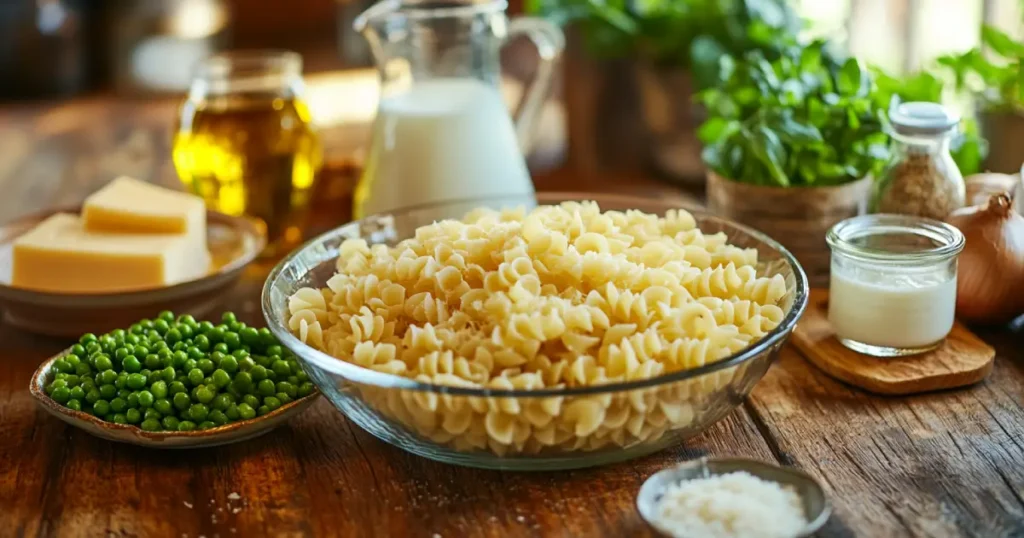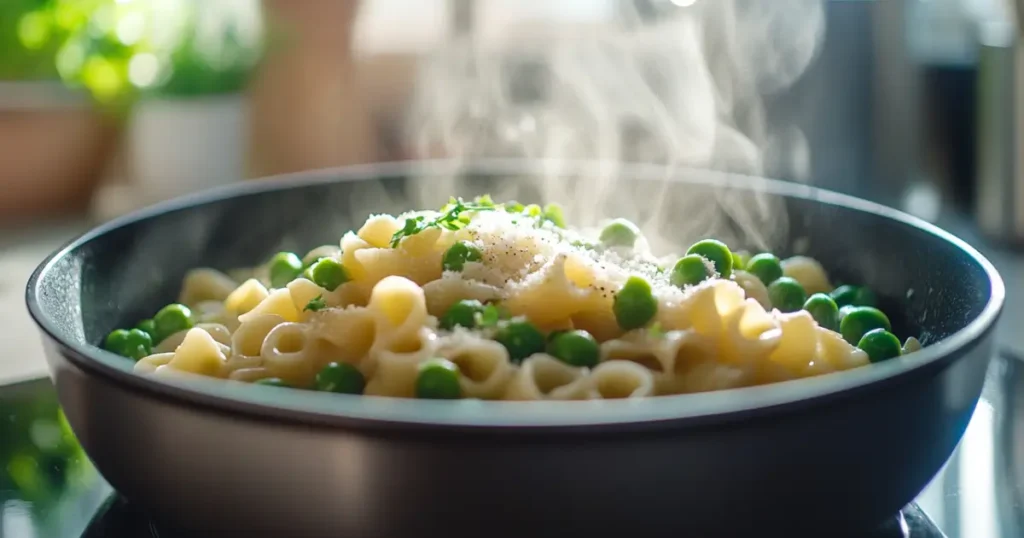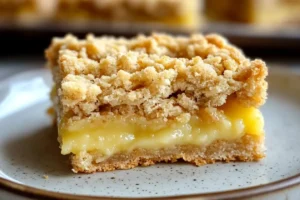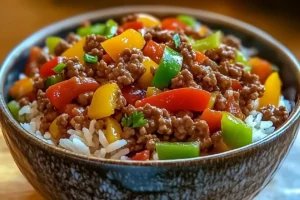Cooking can be a joyful and stress-free experience, especially when whipping up something as comforting as pasta and peas. This dish combines simplicity with deliciousness, using just a handful of ingredients to create a heartwarming meal that satisfies everyone at the table. In this article, we’ll delve into the history of this iconic recipe, break down its ingredients, and guide you step by step to recreate it at home. You’ll also discover pro tips, variations, and storage hacks to elevate your cooking game. Let’s dive in!
Outline
Introduction to Pasta and Peas
What is Pasta and Peas?
Pasta and peas, known as pasta e piselli in Italian, is a rustic yet sophisticated dish deeply rooted in Italian culinary traditions. It’s a hearty one-pot meal made with short pasta, tender peas, and a creamy sauce that’s naturally thickened with pasta starch. This recipe captures the essence of la cucina povera, Italy’s humble, resourceful cooking style.
The History and Cultural Significance of the Dish
Hailing from Southern Italy, this dish emerged as a thrifty solution for feeding families. Peas, often grown in backyard gardens, were paired with pantry staples like pasta and olive oil to create a filling, nutritious meal. Over time, pasta and peas transitioned from being a frugal fare to a celebrated comfort food served across Italian households and restaurants.
Why Pasta and Peas is a Favorite Comfort Food
What makes this dish a staple in so many kitchens? Its appeal lies in its versatility and simplicity. Whether you’re short on time, cooking on a budget, or seeking a wholesome vegetarian option, this recipe ticks all the boxes. The creamy texture of the pasta, the sweetness of peas, and the umami kick of parmesan cheese make it irresistible. Plus, it’s a one-pot wonder, so cleanup is a breeze!
Ingredients Breakdown

For the Pasta and Peas Recipe, you will need:
- Pasta: 1 pound (short pasta like shells, ditalini, or elbow macaroni works best)
- Green Peas: 2 cups (fresh or frozen)
- Onion: 1 medium, finely diced
- Garlic: 2 cloves, minced
- Olive Oil: 3 tablespoons (extra virgin for better flavor)
- Parmesan Cheese: 1/2 cup, grated (optional)
- Vegetable or Chicken Broth: 2 cups
- Heavy Cream or Milk: 1/2 cup (optional for a creamier texture)
- Salt and Pepper: To taste
- Fresh Herbs: Chopped parsley or basil for garnish
- Butter: 2 tablespoons (optional, for added richness)
Step-by-Step Cooking Instructions:
- Prepare the Pasta:
- Bring a large pot of salted water to a boil. Add pasta and cook until al dente according to package instructions.
- Reserve 1 cup of pasta cooking water, then drain and set aside.
- Cook the Peas:
- In a large skillet, heat olive oil over medium heat.
- Add diced onion and cook until softened, about 3-4 minutes. Stir in minced garlic and sauté for another minute.
- Add peas and cook for 2-3 minutes (longer if using fresh peas), stirring occasionally.
- Combine Ingredients:
- Pour in the vegetable or chicken broth and bring to a simmer. Cook for 5-7 minutes, allowing the flavors to meld.
- Add the cooked pasta to the skillet and toss to combine. If needed, stir in reserved pasta water a little at a time to adjust consistency.
- Optional Creamy Version:
- For a creamier dish, stir in heavy cream or milk along with a knob of butter. Simmer for an additional 2-3 minutes.
- Season and Garnish:
- Season with salt and pepper to taste.
- Sprinkle grated Parmesan cheese over the top and toss gently.
- Garnish with fresh parsley or basil before serving.
Tips and Tricks for a Perfect Dish:
- Choosing Pasta: Short pasta shapes work best as they hold the sauce and peas better.
- Cooking the Peas: Avoid overcooking peas to maintain their bright green color and fresh flavor.
- Broth Substitute: If you don’t have broth, use the reserved pasta water with a pinch of salt for added flavor.
- Cheese Alternatives: Pecorino Romano can be used instead of Parmesan for a sharper taste.
Pairing and Serving Suggestions:
Occasions:
- This dish is perfect for a quick weeknight dinner or as a comforting side for a family meal.
Beverage Pairings:
- Pair with a crisp white wine like Sauvignon Blanc or a light Pinot Grigio.
- For non-alcoholic options, a sparkling water with lemon works beautifully.
Presentation:
- Serve in a shallow bowl for easy eating.
- Add a drizzle of olive oil and a sprinkle of Parmesan cheese for an inviting presentation.
Enjoy your delicious and comforting Pasta and Peas!
Tips for Success
How to Achieve the Right Consistency
Getting the perfect consistency is key to making your pasta and peas recipe a success. Start with just enough broth to cover the pasta partially, adding more liquid gradually as needed. Stir often to prevent sticking and to encourage the starch from the pasta to mix with the broth, creating a creamy sauce without adding cream.
Pro Tips for Stirring and Cooking Evenly
Using a large, heavy-bottomed pot, like a Dutch oven, ensures even heat distribution. Stir the pasta frequently but gently—this prevents clumping and helps the flavors meld together. As the liquid reduces, your dish will transform into a luscious, saucy masterpiece.
Enhancing the Flavor with Simple Add-Ins
For an extra flavor punch, consider adding diced pancetta or a sprinkle of fresh herbs like basil or parsley. If you’re a fan of spice, a dash of red pepper flakes can add a delightful kick. These simple touches can elevate your pasta and peas recipe to gourmet status.
Indulge in the perfect combination of flavors with this delicious Steak and Pasta Recipe from Buttery Recipes!
Variations and Add-Ins
Non-Vegetarian Options: Bacon, Ham, and Pancetta
Adding protein can make this dish heartier and even more satisfying. Crispy bacon, diced ham, or savory pancetta are excellent options. Sauté these ingredients with the onions to infuse the dish with rich, smoky flavors.
Vegetarian Alternatives for Added Texture
For a vegetarian twist, toss in sautéed mushrooms or roasted red peppers. These ingredients bring an earthy depth and a pop of color that make the dish as visually appealing as it is tasty.
Creative Additions: Herbs, Spices, and Zest
Brighten your pasta and peas recipe with a squeeze of fresh lemon juice or a sprinkle of lemon zest. Freshly chopped mint or thyme can also lend a delightful aroma and unique taste. Don’t shy away from experimenting with spices like nutmeg or paprika for a surprising flavor boost.
Health Benefits of Peas
Why Peas are Nutrient Powerhouses
Peas are more than just a sweet addition to your pasta and peas recipe; they’re packed with nutrients that benefit your health. These little green gems are an excellent source of plant-based protein, making them perfect for vegetarians and vegans. Plus, they’re rich in dietary fiber, which supports healthy digestion and helps you feel fuller longer.
Caloric and Macronutrient Profile
One cup of peas has only about 125 calories, making them a low-calorie option for adding bulk to meals. They’re also a great source of vitamins C and A, which boost your immune system and promote healthy skin. Their iron content helps maintain energy levels, while the potassium in peas supports heart health. Including them in dishes like this pasta and peas recipe is an easy way to make your meals healthier without sacrificing flavor.
Vitamins and Antioxidants in Peas
Peas are loaded with antioxidants, including flavonoids and carotenoids, which protect against cell damage. Their vitamin K content contributes to strong bones, making them a powerhouse ingredient. By adding peas to your pasta, you’re not only creating a comforting dish but also nourishing your body.
Storage and Reheating Tips
Best Practices for Leftovers
Leftovers from your pasta and peas recipe can be a lifesaver on busy days. Store them in an airtight container in the fridge for up to three days. To prevent the pasta from clumping together, drizzle a bit of olive oil before storing.
Why Freezing is Not Ideal
While freezing is convenient, it’s not the best option for this dish. The pasta and peas can lose their texture and become mushy after thawing. Instead, enjoy this recipe fresh or within a few days for the best flavor and consistency.
Reheating for Perfect Flavor and Texture
To reheat, place the pasta in a saucepan with a splash of water or broth to loosen the sauce. Then, heat it gently over low heat, stirring frequently. Additionally, this method restores the creamy texture and ensures the flavors remain vibrant. Avoid microwaving on high, as it can dry out the dish.
FAQs
What Pasta is Made from Peas?
Pasta made from peas is typically crafted using green peas, yellow peas, or a mix of legume flours. Brands like Banza and Barilla offer pasta made from chickpeas and peas. This type of pasta is gluten-free and high in protein and fiber, making it a popular choice for health-conscious individuals.
What Can Make Pasta Better?
Use Fresh Ingredients: Incorporate fresh herbs, quality cheeses, and high-quality olive oil.
Try Homemade Sauces: Skip jarred sauces for homemade ones using fresh tomatoes or cream.
Add Texture: Top with crunchy breadcrumbs, nuts, or roasted vegetables.
Don’t Overcook: Perfectly cooked pasta enhances the dish’s texture and flavor.
Finish in the Sauce: Toss pasta with the sauce for the last minute of cooking to help it absorb flavors.
Is Pasta Made from Peas Healthy?
Yes, pasta made from peas is a healthy alternative to traditional wheat pasta. It’s rich in protein, dietary fiber, and essential vitamins like iron and potassium. It also has a lower glycemic index, which helps maintain stable blood sugar levels. Plus, it’s gluten-free, making it a great choice for those with gluten sensitivities.
In Closing
Pasta and peas is more than just a simple recipe—it’s a comforting, versatile dish that brings a taste of Italy to your kitchen. Whether you’re cooking for a weeknight dinner or preparing a meal for guests, this one-pot wonder delivers a perfect balance of flavor, nutrition, and ease. With sweet peas, creamy pasta, and the savory kick of parmesan, every bite feels like a warm hug.
To elevate your pasta and peas recipe, pair it with crusty bread, a side of garlic focaccia, or a crisp green salad for a complete meal. A sprinkle of fresh herbs like parsley or a drizzle of olive oil before serving adds a fresh, aromatic touch.
This recipe is a true crowd-pleaser that’s easy to customize to your taste. Its simplicity makes it a go-to comfort food, while its elegance can transform a casual dinner into something special. So grab your pot, gather your ingredients, and enjoy this classic dish that never fails to delight. Buon appetito!




1 thought on “Pasta and Peas Recipe Simple and Delicious”